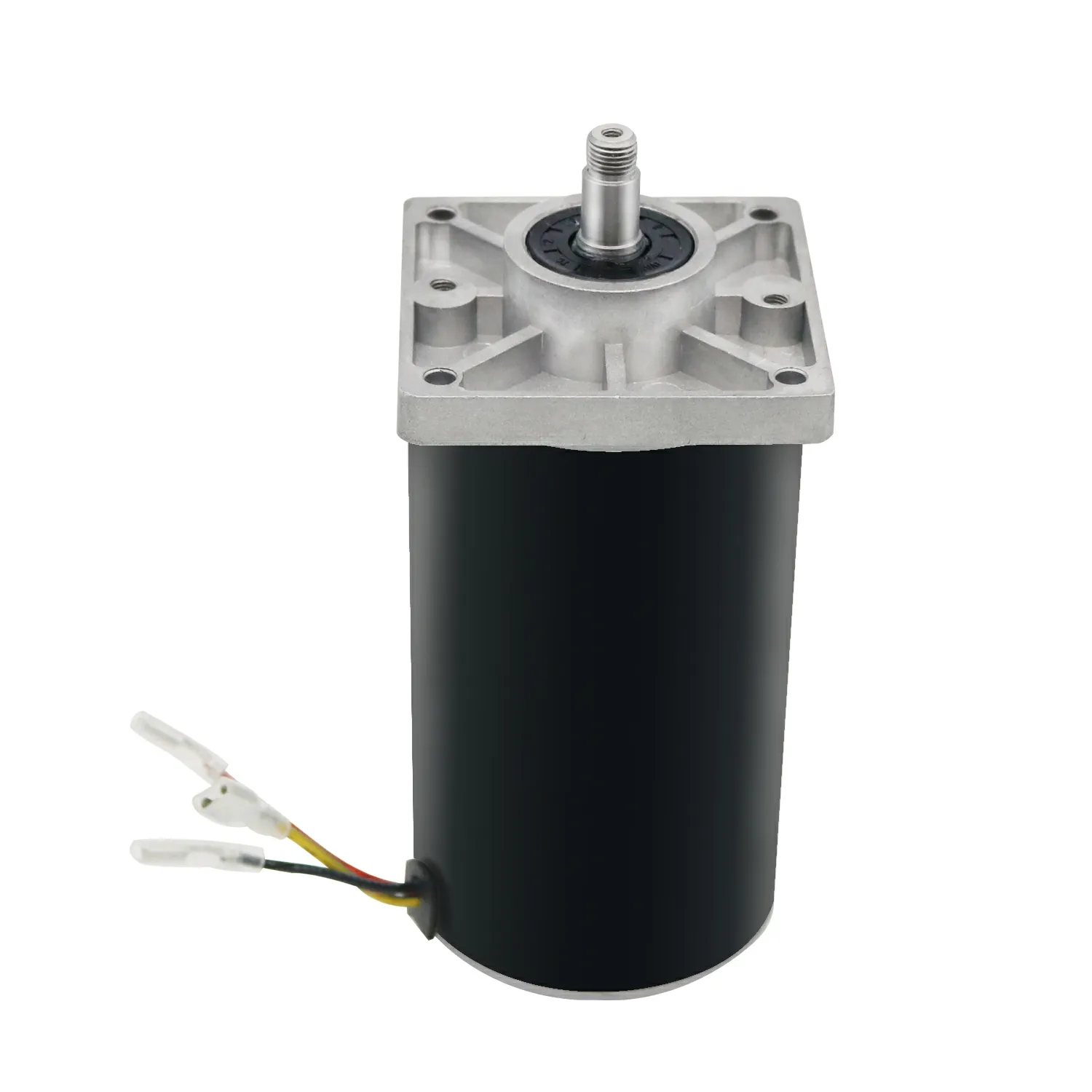ປະຈຳງານທີ່ສຳຄັນສຳລັບມອเตີ້ DC ທີ່ບໍ່ມີແກ້ວ
ຄວາມຫຼຸດແລະຄວາມຕ້ອງການຂອງພະລັງງານ
ການຄວບຄຸມຄວາມຕ້ອງການດ້ານແຮງດັນແລະພະລັງງານເປັນສິ່ງສຳຄັນຫຼາຍເມື່ອຕ້ອງການໃຫ້ມໍເຕີ DC ໂດຍບໍ່ໃຊ້ແປງມີປະສິດທິພາບສູງສຸດ. ເວົ້າເຖິງແຮງດັນ, ສິ່ງທີ່ຖືກນຳໃຊ້ຈະສົ່ງຜົນກະທົບຕໍ່ການດຳເນີນງານຂອງມໍເຕີເຫຼົ່ານີ້. ມໍເຕີສ່ວນຫຼາຍມີແຮງດັນໃນຂອບເຂດທີ່ເໝາະສົມເຊິ່ງຈະຮັກສາການດຳເນີນງານທີ່ສະຫຼາດແລະຍືນຍົງຂອງມັນໄວ້ໄດ້. ແຕ່ຢ່າງໃດກໍຕາມ, ສະພາບການຕ່າງກັນກໍຕ້ອງການສິ່ງທີ່ແຕກຕ່າງກັນ. ຖ້າແຮງດັນສູງເກີນໄປສາມາດເຮັດໃຫ້ມໍເຕີເສຍຫາຍແລະເກີດບັນຫາໃນອະນາຄົດໄດ້, ໃນຂະນະທີ່ແຮງດັນຕ່ຳເກີນໄປກໍບໍ່ສາມາດຮັບປະກັນການດຳເນີນງານທີ່ຖືກຕ້ອງ. ຄວາມຕ້ອງການດ້ານພະລັງງານມັກຈະຖືກວັດແທກໃນໜ່ວຍວັດວັດ (Watts) ແລະ ຄ່ານີ້ແຕກຕ່າງກັນຫຼາຍຂື້ນຢູ່ກັບສະຖານທີ່ນຳໃຊ້. ພິຈາລະນາເບິ່ງອຸປະກອນນ້ອຍໆທີ່ຕ້ອງການພະລັງງານໜ້ອຍຫຼາຍ ແລະ ເຄື່ອງຈັກໃນໂຮງງານທີ່ກິນໄຟຟ້າຫຼວງຫຼາຍ. ການຄົ້ນຄວ້າຈາກ IEEE ໄດ້ສະແດງໃຫ້ເຫັນວ່າມີຄວາມສຳພັນລະຫວ່າງລະດັບແຮງດັນກັບປະສິດທິພາບຂອງມໍເຕີຢ່າງແນ່ນອນ. ການຄວບຄຸມແຮງດັນໃຫ້ຖືກຕ້ອງຈະເຮັດໃຫ້ມໍເຕີດຳເນີນງານໄດ້ດີຂື້ນໂດຍລວມ. ສຳລັບບໍລິສັດທີ່ກຳລັງພິຈາລະນາເບິ່ງສະເພາະຂອງມໍເຕີ, ການເຂົ້າໃຈເລື່ອງນີ້ຈະຊ່ວຍໃຫ້ເລືອກອຸປະກອນທີ່ເໝາະສົມເຊັ່ນ: ມໍເຕີ AC ທີ່ຄວບຄຸມຄວາມໄວຕົວແປໄດ້ ເຊິ່ງເໝາະກັບຄວາມຕ້ອງການໂດຍບໍ່ເສຍຊັບພະຍາກອນໂດຍປາສະຈາກຄວາມຈຳເປັນ.
ຄວາມສัมพันธ์ຂອງໂຕກັບຄວາມເรົ່າ
ຄວາມສຳພັນລະຫວ່າງທອນ (torque) ແລະ ຄວາມເລັວໃນເຄື່ອງຈັກ DC ບໍ່ມີແບຣັດ (brushless DC motors) ຈະຊັບຊ້ອນຂຶ້ນມາແຕ່ກໍຍັງສຳຄັນຫຼາຍໃນການເລືອກເຄື່ອງຈັກທີ່ເໝາະສົມກັບວຽກ. ໃນຫຼາຍໆກໍລະນີ, ທອນຈະຫຼຸດລົງເມື່ອຄວາມເລັວເພີ່ມຂຶ້ນ, ສະນັ້ນການເບິ່ງເສັ້ນສຳພັນລະຫວ່າງທອນ-ຄວາມເລັວ (torque-speed curves) ຈຶ່ງເປັນສິ່ງຈຳເປັນກ່ອນເລືອກເຄື່ອງຈັກສຳລັບການໃຊ້ງານໃນແຕ່ລະດ້ານ. ຈາກປະສົບການ: ເວລາທີ່ມີບາງສິ່ງບາງຢ່າງທີ່ໜັກຕ້ອງການໃຫ້ເຄື່ອນໄຫວຢ່າງໄວວາ, ພວກເຮົາຕ້ອງການທອນຫຼາຍ. ແຕ່ຖ້າຈຸດປະສົງແມ່ນໃຫ້ແຂນຫຸ່ນຍົນເຄື່ອນໄຫວໄວ, ຄວາມເລັວກໍຈະສຳຄັນກ່ວາກຳລັງ. ອຸດສາຫະກຳຍັງໄດ້ກຳນົດມາດຕະຖານເຊັ່ນດຽວກັນ, ຕົວຢ່າງຄືສິ່ງທີ່ NEMA ແນະນຳກ່ຽວກັບຈຳນວນທອນທີ່ຄວນຈະສອດຄ່ອງກັບຄວາມເລັວຕ່າງໆເພື່ອໃຫ້ທຸກຢ່າງດຳເນີນໄປຢ່າງລຽນລ້ຳ. ການເບິ່ງລາຍລະອຽດຂອງຕົວເລກເຫຼົ່ານີ້ຢ່າງລະມັດລະວັງຈະຊ່ວຍໃຫ້ວິສະວະກອນເລືອກກຳໜົດຄ່າເຄື່ອງຈັກທີ່ເໝາະສົມກັບສິ່ງທີ່ພວກເຂົາກຳລັງພະຍາຍາມບັນລຸໄດ້ໃນໂຮງງານຜະລິດ ຫຼື ບ່ອນອື່ນທີ່ເຄື່ອງຈັກເຫຼົ່ານີ້ໄປສິ້ນສຸດລົງ.
ຄວາມສາມາດຂອງ RPM ສູງສຳລັບວຽກທີ່ມີຄວາມແນວ
ຄວາມສາມາດໃນການບັນລຸ RPM ສູງແມ່ນສຳຄັນຫຼາຍເມື່ອເຮັດວຽກກ່ຽວກັບວຽກທີ່ຕ້ອງການຄວາມແທດເຊິ່ງຄວາມຖືກຕ້ອງ ແລະ ການຕອບສະໜອງທີ່ໄວ. ພິຈາລະນາເຖິງສິ່ງຕ່າງໆເຊັ່ນ ແຂນຫຸ່ນຍົນ ຫຼື ເຄື່ອງຈັກ CNC ທີ່ຕ້ອງການຍ້າຍຊິ້ນສ່ວນດ້ວຍຄວາມແທດເຊິ່ງແທ້ຈິງ. ການນຳໃຊ້ແບບນີ້ຂຶ້ນກັບເຄື່ອງຈັກທີ່ສາມາດປັ່ນໄດ້ຢ່າງຕໍ່ເນື່ອງໃນຄວາມໄວສູງໃນຂະນະທີ່ຍັງຄົງຄວບຄຸມການເຮັດວຽກຂອງພວກມັນໄດ້. ການສ້າງຂອງມັນກໍ່ສຳຄັນເຊັ່ນກັນ. ຮູບແບບການອອກແບບ ແລະ ການດຸນດ່ຽງຂອງເຄື່ອງຈັກສາມາດມີບົດບາດໃນການເພີ່ມຕົວເລກ RPM ໄດ້. ວຽກວິໄຈຫຼ້າສຸດຈາກ IEEE Robotics ໄດ້ສຶກສາກ່ຽວກັບວິທີການເຄື່ອງຈັກບໍ່ມີແປງໄຟຟ້າໄວເຮັດວຽກໃນສະພາບແວດລ້ອມຫຸ່ນຍົນໃນຄວາມເປັນຈິງ ແລະ ພົບວ່າມັນດີຂຶ້ນໃນການຄວບຄຸມຄວາມຖືກຕ້ອງຂອງການເຄື່ອນໄຫວຢ່າງຫຼວງຫຼາຍ. ເມື່ອຜູ້ຜະລິດໃຫ້ຄວາມສຳຄັນກັບການອອກແບບເຄື່ອງຈັກຂັ້ນສູງ, ພວກເຂົາກໍ່ສາມາດໄດ້ຮັບເຄື່ອງມືທີ່ປະຕິບັດໄດ້ຢ່າງເຊື່ອຖືໄດ້ແທ້ຈິງເຖິງແມ່ນວ່າຈະຖືກກົດດັນ. ສິ່ງນີ້ເຮັດໃຫ້ມີຄວາມແຕກຕ່າງໃນຂະແໜງຕ່າງໆເຊັ່ນ ການຜະລິດອຸປະກອນການແພດ, ສ່ວນປະກອບການບິນ, ແລະ ແຖວການປະຊຸມອັດຕະໂນມັດທີ່ຄວາມດີຂຶ້ນນ້ອຍໆສາມາດແປງເປັນການປັບປຸງໃນຄຸນນະພາບຜະລິດຕະພັນ.
ການเปรียบเทียบປະເພດຂອງເຄື່ອງປະຕິບັດ: BLDC vs เครื่องปั่นไฟ AC ການເປັນປະຈຳ
ຄວາມແຕກຕ່າງຂອງຄວາມຫຼັງຫຼາຍ
ເມື່ອເບິ່ງວ່າມໍເຕີ້ແຕ່ລະປະເພດມີປະສິດທິພາບແນວໃດ, ມໍເຕີ້ DC ບໍ່ມີແປງ (BLDC) ມັກຈະດີກ່ວາມໍເຕີ້ AC ປ່ຽນຄວາມໄວໄດ້. ເນື່ອງຈາກບໍ່ມີແປງທີ່ສ້າງຄວາມຕ້ານທາງກົນຈັກ, ມໍເຕີ້ເຫຼົ່ານີ້ສາມາດເຮັດວຽກໄດ້ດີຂຶ້ນເປັນພິເສດໃນເວລາທີ່ຄວາມສາມາດເຮັດວຽກມີຄວາມສຳຄັນຫຼາຍເຊັ່ນໃນກ້ອງຖ່າຍຮູບຍົນບິນຫຼືລົດໄຟຟ້າທີ່ແລ່ນຢູ່ຕາມຖະໜົນ. ມັນຍັງຊ່ວຍຍືດອາຍຸການໃຊ້ງານຂອງແບັດເຕີຣີ້ອີກດ້ວຍ, ເຊິ່ງເປັນເລື່ອງໃຫຍ່ຫຼວງສຳລັບຜູ້ທີ່ກຳລັງເຮັດວຽກກ່ຽວກັບເທກໂນໂລຊີການຂົນສົ່ງ. ອົງການພະລັງງານສາກົນໄດ້ດຳເນີນການຄົ້ນຄວ້າບາງຢ່າງທີ່ສະແດງໃຫ້ເຫັນວ່າການເລືອກມໍເຕີ້ທີ່ເໝາະສົມສາມາດຫຼຸດຜ່ອນທັງຄ່າໃຊ້ຈ່າຍໃນບິນໄຟຟ້າແລະສິ່ງທີ່ຖືກປ່ອຍອອກມາໃນສິ່ງແວດລ້ອມ. ສຳລັບບໍລິສັດຕ່າງໆທີ່ພະຍາຍາມປະຢັດເງິນໃນຂະນະທີ່ຮັກສາສິ່ງແວດລ້ອມໃນເວລາດຽວກັນ, ການເລືອກໃຊ້ມໍເຕີ້ BLDC ທີ່ມີປະສິດທິພາບສູງແມ່ນເປັນເລື່ອງທີ່ມີເຫດຜົນທາງດ້ານເສດຖະກິດແລະສິ່ງແວດລ້ອມ.
ຄວາມ:flexibility ຂອງການຄົ້ນຫາ
ເຄື່ອງຈັກ BLDC ສະເໜີການຄວບຄຸມຄວາມໄວໄດ້ດີກວ່າເນື່ອງຈາກການອອກແບບທີ່ແນ່ນອນ, ເຊິ່ງເປັນສິ່ງສຳຄັນຫຼາຍໃນການນຳໃຊ້ທີ່ຕ້ອງການຄວາມຖືກຕ້ອງ. ເຄື່ອງຈັກເຫຼົ່ານີ້ບໍ່ໄດ້ມີລັກສະນະຄືກັບເຄື່ອງຈັກ AC ປ່ຽນຄວາມໄວແບບດັ້ງເດີມ. ພວກມັນສາມາດປ່ຽນຄວາມໄວໄດ້ຢ່າງໄວວາແລະຖືກຕ້ອງ, ສິ່ງທີ່ເຮັດໃຫ້ແຕກຕ່າງກັນໃນການນຳໃຊ້ດ້ານຫຸ່ນຍົນ, ເຊິ່ງເວລາທີ່ຖືກຕ້ອງແມ່ນສິ່ງສຳຄັນຫຼາຍ. ຍິ່ງໄປກວ່ານັ້ນ, ບໍ່ມີການສຶກຂອງແປງເນື່ອງຈາກການເສຍດສີ, ພ້ອມທັງການປ່ຽນແປງແບບອີເລັກໂທຣນິກຊ່ວຍໃຫ້ພວກມັນມີຂໍ້ດີ. ສິ່ງນີ້ເຮັດໃຫ້ພວກມັນສາມາດບັນລຸເປົ້າໝາຍຄວາມໄວທີ່ແນ່ນອນດ້ວຍຄວາມຊ້າລົງລະຫວ່າງຄຳສັ່ງຕ່າງໆໜ້ອຍທີ່ສຸດ. ສະນັ້ນ, ເຄື່ອງຈັກເຫຼົ່ານີ້ສາມາດຄວບຄຸມໄດ້ຢ່າງສະໝໍ່າສະເໝີຕະຫຼອດການດຳເນີນງານ, ເຮັດໃຫ້ພວກມັນເປັນທີ່ນິຍົມໃນທັງລະບົບອັດຕະໂນມັດໃນໂຮງງານ ແລະ ອຸປະກອນທີ່ໃຊ້ໃນບ້ານທົ່ວໄປ.
ຄວາມສຸດສະຫງົດສະເພາະການໃຊ້
ໃນກໍລະນີຂອງການນໍາໃຊ້ງານພິເສດ ມໍເຕີ DC ບໍ່ມີແບຣັດ (BLDC) ມັກຈະດີກ່ວາມໍເຕີ AC ປ່ຽນຄວາມໄວໄດ້ ເນື່ອງຈາກມັນເຮັດວຽກໄດ້ດີກ່ວາໃນສະພາບການບາງຢ່າງ. ບໍລິສັດຫຸ້ນຍົນ ບໍລິສັດຜະລິດທາງອາກາດອາວະກາດ ແລະ ແມ້ກະທັ້ງບາງສະຖານທີ່ຜະລິດລະດັບສູງກໍ່ໄດ້ປ່ຽນໄປໃຊ້ເຕັກໂນໂລຊີ BLDC ໂດຍສົມບູນ. ເປັນຫຍັງ? ເນື່ອງຈາກມໍເຕີເຫຼົ່ານີ້ມີປະສິດທິພາບດີຂຶ້ນ ສາມາດຄວບຄຸມການເຄື່ອນໄຫວໄດ້ລະອຽດຫຼາຍຂຶ້ນ ແລະ ມີກໍາລັງສູງຫຼາຍຂຶ້ນເມື່ອປຽບທຽບກັບຂະໜາດຂອງມັນ ສົມທຽບກັບທາງເລືອກດັ້ງເດີມ. ຕາມຂໍ້ມູນອຸດສະຫະກໍາລະດັບສົມໄດ້ລະບຸວ່າ ປັດຈຸບັນມໍເຕີ BLDC ກິນສ່ວນຕະຫຼາດໄດ້ປະມານ 70% ໃນການນໍາໃຊ້ງານທີ່ນ້ໍາໜັກ ແລະ ພື້ນທີ່ມີຄວາມສໍາຄັນຫຼາຍ. ວິສະວະກອນທີ່ເຄີຍເຮັດວຽກກັບມໍເຕີທັງສອງປະເພດນີ້ ສະເໝີເນັ້ນວ່າການເລືອກໃຊ້ BLDC ຈະເຮັດໃຫ້ແຕກຕ່າງກັນຫຼາຍໃນການນໍາໃຊ້ງານທີ່ມີສະພາບການຫຍຸ້ງຍາກ ຫຼື ມີຂໍ້ກໍານົດທີ່ເຂັ້ມງວດ ທີ່ມໍເຕີປົກກະຕິບໍ່ສາມາດຮັບມືໄດ້.
ເກິດຂຶ້ນເປັນພິສູດການເລືອກເສັ້ນ
ຄວາມຕ້ອງການຂອງອຸຕຳພານ
ເມື່ອເບິ່ງລະບົບອັດຕະໂນມັດໃນອຸດສາຫະກໍາ, ປັດໃຈຕ່າງໆເຊັ່ນ: ອາຍຸການໃຊ້ງານຂອງເຄື່ອງຈັກ, ຄວາມໄວໃນການດໍາເນີນງານ, ແລະ ຄວາມສາມາດໃນການເຮັດວຽກຢ່າງຕໍ່ເນື່ອງ ມີຄວາມສໍາຄັນຫຼາຍຕໍ່ຜູ້ຈັດການໂຮງງານ. ນັ້ນແມ່ນເຫດຜົນທີ່ໂຮງງານຫຼາຍແຫ່ງຫັນມາໃຊ້ມໍເຕີ DC ໂດຍບໍ່ມີແປງ (BLDC) ແທນທີ່ຈະໃຊ້ທາງເລືອກດັ້ງເດີມ. ມໍເຕີເຫຼົ່ານີ້ສາມາດໃຊ້ໄດ້ດົນຂຶ້ນໃນໄລຍະຍາວ ແລະ ສາມາດເຮັດວຽກໄດ້ດີເຖິງແມ່ນວ່າອຸນຫະພູມຈະປ່ຽນແປງ ຫຼື ມີຝຸ່ນຢູ່ໃນອາກາດ. ລັກສະນະການອອກແບບດັ້ງເດີມຍັງຊ່ວຍຫຼຸດບັນຫາການບໍາລຸງຮັກສາເນື່ອງຈາກວ່າມັນບໍ່ສຶກເສຍຍໄວເຊັ່ນດຽວກັບມໍເຕີທີ່ມີແປງ. ຕົວຢ່າງເຊັ່ນ: ໂຮງງານຜະລິດລົດຍົນ. ບັນດາຜູ້ຜະລິດລົດຍົນໃຫຍ່ຫຼາຍຄົນໄດ້ເຫັນປະໂຫຍດທີ່ຈັບຕ້ອງໄດ້ຫຼັງຈາກທີ່ປ່ຽນຊຸດມໍເຕີເກົ່າມາເປັນເຕັກໂນໂລຢີ BLDC ທີ່ຖືກຕ້ອງຕາມມາດຕະຖານ ISO. ຕົວເລກການຜະລິດເພີ່ມຂຶ້ນ ແລະ ການຢຸດເຊົາທີ່ບໍ່ໄດ້ວາງແຜນໄວ້ຫຼຸດລົງຫຼາຍໃນແຕ່ລະແຖວຂອງສາຍການຜະລິດ.
ຄວາມຕ້ອງການຂອງໂຣບອດແລະໂດນ
ໃນເວລາທີ່ເວົ້າເຖິງ ຫຸ້ນຍົນ ແລະ ຍົນບິນຄວບຄຸມຈາກໄລຍະໄກ (drones), ຄຸນສົມບັດເຄື່ອງຈັກບາງຢ່າງມີຄວາມສຳຄັນຫຼາຍ - ຂະໜາດ, ນ້ຳໜັກ, ແລະ ກຳລັງທີ່ມັນສາມາດຜະລິດໄດ້ເມື່ອທຽບໃສ່ນ້ຳໜັກຂອງມັນເອງ. ນັ້ນແມ່ນເຫດຜົນທີ່ເຄື່ອງຈັກໄຟຟ້າປະເພດ BLDC (brushless DC motors) ໄດ້ກາຍເປັນທີ່ນິຍົມໃນຂົງເຂດເຫຼົ່ານີ້. ຄວາມເປັນຈິງທີ່ວ່າພວກມັນມີນ້ຳໜັກເບົາແຕ່ມີປະສິດທິພາບສູງ ຈິ່ງຊ່ວຍໃຫ້ຍົນບິນຄວບຄຸມຈາກໄລຍະໄກສາມາດບິນຢູ່ໃນອາກາດໄດ້ດົນຂຶ້ນ ແລະ ສາມາດເຄື່ອນໄຫວໄດ້ດີຂຶ້ນ. ນອກຈາກນັ້ນ, ຄວາມສາມາດໃນການຄວບຄຸມຢ່າງແນ່ນອນຍັງໝາຍເຖິງການທີ່ຫຸ້ນຍົນສາມາດປະຕິບັດວຽກງານໄດ້ຢ່າງລຽນລ້ຳໂດຍບໍ່ມີການສັ່ນຊັກ ຫຼື ເຄື່ອນໄຫວຢ່າງສະທໍ່ສົນ. ສ່ວນຫຼາຍຂອງຜູ້ຜະລິດຍົນບິນຄວບຄຸມຈາກໄລຍະໄກໃຫຍ່ໆ ຈະພິຈາລະນາປັດໃຈເຫຼົ່ານີ້ເວລາເລືອກເຄື່ອງຈັກສຳລັບຮຸ່ນໃໝ່ຂອງພວກເຂົາ. ສຸດທ້າຍແລ້ວ, ບໍ່ມີໃຜຢາກໃຫ້ຍົນບິນຕົກເນື່ອງຈາກເຄື່ອງຈັກບໍ່ດີພໍ. ສຳລັບຜູ້ທີ່ກຳລັງເຮັດໂຄງການຫຸ້ນຍົນຂັ້ນສູງ ຫຼື ກຳລັງພັດທະນາລະບົບບໍ່ມີຄົນຂັບຂີ່ໃໝ່, ການໄດ້ເຄື່ອງຈັກ BLDC ທີ່ເໝາະສົມສາມາດເຮັດໃຫ້ແຕກຕ່າງກັນລະຫວ່າງຄວາມສຳເລັດ ແລະ ຄວາມລົ້ມເຫຼວໃນສະພາບແວດລ້ອມທີ່ແທ້ຈິງ.
ວົງຈັກການເຮັດວຽກທີ່ໜຶ່ງແລະວົງຈັກການເຮັດວຽກທີ່ຫຼາຍ
ການຮູ້ວິທີການເຮັດວຽກຂອງມໍເຕີແບບຕໍ່ເນື່ອງ ແລະ ແບບເປັນຈັງຫວະສາມາດເຮັດໃຫ້ເກີດຄວາມແຕກຕ່າງໃນການເລືອກມໍເຕີສໍາລັບການນໍາໃຊ້ໃນຊີວິດຈິງ. ການເຮັດວຽກແບບຕໍ່ເນື່ອງໝາຍເຖິງການດໍາເນີນງານຢ່າງຕໍ່ເນື່ອງ, ສະນັ້ນມໍເຕີເຫຼົ່ານີ້ຈຶ່ງຕ້ອງການຄວາມອົດທົນ ແລະ ການໃຫ້ຄະແນນປະສິດທິພາບທີ່ດີ. ສໍາລັບການເຮັດວຽກແບບເປັນຈັງຫວະນັ້ນແຕກຕ່າງກັນເນື່ອງຈາກມັນໃຫ້ມໍເຕີພັກລະຫວ່າງການດໍາເນີນງານ, ເຊິ່ງມັກຈະເຮັດໃຫ້ມັນຢືນຢົງຍາວນານ ແລະ ຮັບຄວາມເສຍຫາຍໜ້ອຍລົງຕະຫຼອດເວລາ. ການຄົ້ນຄວ້າໃນອຸດສາຫະກໍາສະແດງໃຫ້ເຫັນວ່າການເລືອກການເຮັດວຽກໃຫ້ຖືກຕ້ອງມີຄວາມສໍາຄັນຫຼາຍຕໍ່ທັງອາຍຸການໃຊ້ງານ ແລະ ປະສິດທິພາບຂອງມໍເຕີ. ສໍາລັບຜູ້ທີ່ກໍາລັງເບິ່ງມໍເຕີ BLDC ໂດຍສະເພາະ, ການພິຈາລະນາຢ່າງລະອອຍກ່ຽວກັບປະເພດຂອງການເຮັດວຽກທີ່ແຕ່ລະການນໍາໃຊ້ຕ້ອງການບໍ່ພຽງແຕ່ແນະນໍາເທົ່ານັ້ນ, ແຕ່ຍັງເປັນສິ່ງຈໍາເປັນຖ້າພວກເຂົາຕ້ອງການໃຫ້ລະບົບຂອງພວກເຂົາດໍາເນີນໄປຢ່າງລຽນລ້ອມໃນຂະນະທີ່ຄວບຄຸມຄ່າໃຊ້ຈ່າຍໃນການບໍາລຸງຮັກສາໃຫ້ຕໍ່າ.
ການເລືອກຂັ້ນໜຶ່ງເປັນໜຶ່ງ
ການນຶ່ງຄວາມສຳພາດ
ການເລືອກເຄື່ອງຈັກທີ່ເໝາະສົມເລີ່ມຕົ້ນດ້ວຍການກຳນົດວ່າຄຸນລັກສະນະໃນການດຳເນີນງານໃດແດ່ທີ່ສຳຄັນທີ່ສຸດ. ສິ່ງທີ່ຕ້ອງເບິ່ງເປັນພິເສດແມ່ນຄວາມສາມາດໃນການຮັບນ້ຳໜັກ ແລະ ຄວາມໄວ້ທີ່ຕ້ອງການໃຊ້ເນື່ອງຈາກສອງຢ່າງນີ້ມີຜົນກະທົບໂດຍກົງຕໍ່ການເຮັດວຽກຂອງເຄື່ອງຈັກໃນສະພາບການໃຊ້ງານທີ່ແທ້ຈິງ. ເພື່ອໃຫ້ໄດ້ຂໍ້ມູນທີ່ຖືກຕ້ອງກ່ຽວກັບປັດໃຈເຫຼົ່ານີ້, ວິສະວະກອນມັກຈະໃຊ້ການທຳນາຍຜ່ານແບບຈຳລອງດ້ວຍຄອມພິວເຕີ ຫຼື ກວດເບິ່ງບັນທຶກການປະຕິບັດງານໃນອະດີດຈາກການຕັ້ງຄ່າທີ່ຄ້າຍຄືກັນ. ສຳລັບຕົວຢ່າງ, ໃນໂຮງງານຜະລິດຕະພັນບ່ອນທີ່ເຄື່ອງຈັກມັກຈະຕ້ອງເຮັດວຽກກັບລະບົບຄວາມຖີ່ປ່ຽນແປງ, ສະພາບການດັ່ງກ່າວຕ້ອງການຕົວເລກທີ່ແນ່ນອນກ່ຽວກັບຄວາມຕ້ອງການດ້ານນ້ຳໜັກ ແລະ ຄວາມໄວ. ການເຂົ້າໃຈໃນລາຍລະອຽດຂອງສະເພາະດ້ານເຫຼົ່ານີ້ຍັງຊ່ວຍໃຫ້ເຄື່ອງຈັກສາມາດເຮັດວຽກໄດ້ດີຂຶ້ນໃນໄລຍະຍາວອີກດ້ວຍ. ນ້ຳໜັກທີ່ຮັບມັກຈະແຕກຕ່າງກັນລະຫວ່າງນ້ຳໜັກເບົາທີ່ຕ່ຳກວ່າ 10 ນິວຕັນ-ແມັດເຖິງການໃຊ້ງານທີ່ໜັກໜ່ວງເກີນ 50 Nm. ຄວາມຕ້ອງການດ້ານຄວາມໄວກໍມີຂອບເຂດກ້ວາງເຊັ່ນກັນ, ຈາກສ່ວນປະກອບທີ່ເຄື່ອນໄຫວຊ້າກ່ວາ 2000 ວົງຕໍ່ນາທີ ເຖິງການໃຊ້ງານຄວາມໄວສູງທີ່ຕ້ອງການຫຼາຍກ່ວາ 10,000 RPM.
ການພິຈາລະນາສິ່ງປ່ອນລະດັບ
ສິ່ງຕ່າງໆເຊັ່ນ: ການປ່ຽນແປງຂອງອຸນຫະພູມ, ລະດັບຄວາມຊຸ່ມ, ແລະ ການສັ່ມຜົນກັບສານເຄມີ ມີຜົນກະທົບຫຼາຍຕໍ່ການເຮັດວຽກຂອງເຄື່ອງຈັກໃນໄລຍະຍາວ. ການເຂົ້າໃຈສິ່ງເຫຼົ່ານີ້ໃຫ້ຖືກຕ້ອງເປັນສິ່ງສຳຄັນຍ້ອນວ່າເຄື່ອງຈັກຈະບໍ່ສາມາດເຮັດວຽກໄດ້ດີຖ້າບໍ່ໄດ້ຖືກອອກແບບໃຫ້ເໝາະກັບສະພາບແວດລ້ອມທີ່ມັນຈະຕ້ອງເຮັດວຽກ. ສຳລັບຕົວຢ່າງ, ຄວາມຮ້ອນ: ເຄື່ອງຈັກອຸດສາຫະກຳສ່ວນຫຼາຍທີ່ເຮັດວຽກໃນສະພາບແວດລ້ອມຮ້ອນຈະຕ້ອງການວິທີແກ້ໄຂເພື່ອລະບາຍຄວາມຮ້ອນເພີ່ມເຕີມຕັ້ງແຕ່ຂັ້ນຕອນການອອກແບບ. ຂະບວນການເລືອກເຄື່ອງຈັກໂດຍທົ່ວໄປແລ້ວໝາຍເຖິງການເລືອກເຄື່ອງຈັກທີ່ມີລະດັບການປ້ອງກັນ (enclosure ratings) ແລະ ຂໍ້ກຳນົດດ້ານການລະບາຍຄວາມຮ້ອນທີ່ເໝາະສົມຕາມມາດຕະຖານທີ່ພວກເຮົາຄຸ້ນເຄີຍເຊັ່ນ: ມາດຕະຖານ IP ທີ່ບອກພວກເຮົາວ່າເຄື່ອງຈັກນັ້ນມີການປ້ອງກັນຕໍ່ການເຂົ້າຂອງຝຸ່ນ ແລະ ນ້ຳໄດ້ດີປານໃດ. ກຸ່ມອຸດສາຫະກຳເຊັ່ນ: IEEE ກໍ່ໄດ້ເຜີຍແຜ່ຄຳແນະນຳກ່ຽວກັບສະພາບແວດລ້ອມທີ່ເຄື່ອງຈັກແຕ່ລະປະເພດຄວນຈະສາມາດຮັບມືໄດ້ ເຊິ່ງຊ່ວຍຜູ້ຜະລິດໃຫ້ຕອບສະໜອງຄວາມຕ້ອງການໃນອຸດສາຫະກຳທີ່ຊັບຊ້ອນ ແລະ ຮັບປະກັນວ່າອຸປະກອນທີ່ຕິດຕັ້ງຈະສາມາດໃຊ້ງານໄດ້ຕາມອາຍຸການໃຊ້ງານທີ່ຄາດໝາຍໄວ້ໂດຍບໍ່ມີການເສຍຫຼາຍຄັ້ງ ຫຼື ການເສື່ອມສະພາບກ່ອນເວລາອັນຄວນ.
ຄຳແນະກ່ຽວກັບການປັບແກ້ແລະການເປັນເປັນ
Thai: ປະຕິບັດການຫຼັງ
ການໃຊ້ງານເຄື່ອງຈັກໄຟຟ້າປະເພດ Brushless DC ໃຫ້ມີປະສິດທິພາບສູງສຸດ ຕ້ອງເຂົ້າໃຈກ່ຽວກັບການຄວບຄຸມຄວາມຮ້ອນຂອງມັນ ໂດຍສະເພາະໃນເວລາທີ່ເຄື່ອງຈັກເຮັດວຽກໜັກຕະຫຼອດເວລາ. ຖ້າເຄື່ອງຈັກປະເພດນີ້ເຮັດວຽກຕໍ່ເນື່ອງໂດຍບໍ່ມີການລະບາຍຄວາມຮ້ອນທີ່ເພຍງພໍ ມັນຈະເລີ່ມຮ້ອນເກີນໄປ ແລະ ສົ່ງຜົນໃຫ້ປະສິດທິພາບຫຼຸດລົງຕາມການໃຊ້ງານ. ມີຫຼາຍວິທີໃນການຄວບຄຸມຄວາມຮ້ອນ. ວິທີງ່າຍດາຍທີ່ສຸດແມ່ນການລະບາຍຄວາມຮ້ອນດ້ວຍອາກາດ ເຊິ່ງມີຄ່າໃຊ້ຈ່າຍຕໍ່າ ແລະ ສະດວກໃນການບຳລຸງຮັກສາ ແຕ່ຈະບໍ່ມີປະສິດທິພາບດີໃນສະພາບແວດລ້ອມທີ່ມີອຸນຫະພູມສູງ. ສຳລັບຜົນໄດ້ຮັບທີ່ດີຂື້ນ ສະຖານທີ່ຫຼາຍແຫ່ງຫັນມາໃຊ້ລະບົບລະບາຍຄວາມຮ້ອນດ້ວຍນ້ຳ. ລະບົບດັ່ງກ່າວສາມາດລະບາຍຄວາມຮ້ອນໄດ້ດີກ່ວາແຕ່ມີຄ່າໃຊ້ຈ່າຍເພີ່ມຂື້ນ ແລະ ຄວາມສ່ຽງຈາກການຮົ່ວໄຫຼ. ການບຳລຸງຮັກສາມີບົດບາດສຳຄັນຫຼາຍໃນເລື່ອງນີ້. ການກຳນົດແຜນການກວດສອບເປັນປະຈຳ ທີ່ສອດຄ່ອງກັບສະພາບການໃຊ້ງານຕົວຈິງຂອງເຄື່ອງຈັກ ຈະຊ່ວຍໃຫ້ແນ່ໃຈວ່າທຸກຢ່າງຍັງຄົງເຮັດວຽກໄດ້ດີ.
ແยົກແບບການປົກປ້ອນລ່ວງໜ້າ
ວິທີທີ່ອຸດສາຫະກໍາຈັດການກັບອາຍຸການໃຊ້ງານຂອງເຄື່ອງຈັກກໍາລັງປ່ຽນແປງຢ່າງໄວວາດ້ວຍເຕັກນິກການບໍາລຸງຮັກສາແບບຄາດການ. ວິທີການດັ້ງເດີມອີງໃສ່ຕາຕະລາງການບໍາລຸງຮັກສາທີ່ແນ່ນອນ, ແຕ່ປັດຈຸບັນບໍລິສັດຕ່າງໆກໍາລັງຫັນໄປໃຊ້ການວິເຄາະຂໍ້ມູນ ແລະ ອຸປະກອນທີ່ເຊື່ອມຕໍ່ກັບອິນເຕີເນັດເພື່ອຄົ້ນຫາບັນຫາກ່ອນທີ່ມັນຈະເກີດຂຶ້ນ. ດ້ວຍເຊັນເຊີຕ່າງໆທີ່ເຊື່ອມຕໍ່ຜ່ານເຄືອຂ່າຍລວງລະດັບ, ຜູ້ຈັດການໂຮງງານສາມາດຮັບຂໍ້ມູນປັບປຸງຢ່າງຕໍ່ເນື່ອງກ່ຽວກັບການປະຕິບັດງານຂອງເຄື່ອງຈັກໃນແຕ່ລະມື້. ລະບົບເຕືອນໄພໃນໄລຍະຕົ້ນນີ້ສາມາດຄົ້ນພົບບັນຫານ້ອຍໆກ່ອນທີ່ຈະກາຍເປັນບັນຫາໃຫຍ່. ຕາມການຄົ້ນຄວ້າຈາກ Deloitte, ບັນດາທຸລະກິດທີ່ນໍາໃຊ້ລະບົບການສັງເກດການອັດຈະນະລິດເຫຼົ່ານີ້ ສາມາດປະຢັດຄ່າໃຊ້ຈ່າຍດ້ານການບໍາລຸງຮັກສາໄດ້ປະມານ 20 ຫາ 30 ເປີເຊັນ. ອຸປະກອນກໍຍັງສາມາດໃຊ້ງານໄດ້ດົນຂຶ້ນ, ກັບການຫຼຸດລົງຂອງການຢຸດເຊົາການດໍາເນີນງານໃນຂອບເຂດ 10 ຫາ 20 ເປີເຊັນໃນແຕ່ລະສະຖານທີ່. ແລະ ຢ່າງເປັນທໍາມະຊາດ, ສິ່ງນີ້ຫມາຍຄວາມວ່າເຄື່ອງຈັກຈະສາມາດໃຊ້ງານໄດ້ດົນກ່ວາເກົ່າຫຼາຍພາຍໃຕ້ການປະຕິບັດການບໍາລຸງຮັກສາແບບດັ້ງເດີມ.
ການອັບເດດເພື່ອຄວາມມີຄວາມສັນ
ໃນປັດຈຸບັນນີ້ ການປ່ຽນມາໃຊ້ເຄື່ອງຈັກໄຟຟ້າ DC ທີ່ປະຢັດພະລັງງານແມ່ນມີຂໍ້ດີທີ່ແທ້ຈິງ, ໂດຍສະເພາະໃນສະພາບທີ່ຄ່າໄຟຟ້າເພີ່ມຂື້ນ ແລະ ການຮັກສາສິ່ງແວດລ້ອມກາຍເປັນສິ່ງຈຳເປັນສຳລັບບໍລິສັດຕ່າງໆ. ກັບການລົງທຶນໃນດ້ານນີ້ ກໍ່ມີຜົນຕອບແທນທີ່ດີເຊັ່ນກັນ, ເນື່ອງຈາກຄ່າໃຊ້ຈ່າຍໃນການດຳເນີນງານທີ່ຕໍ່າລົງໃນແຕ່ລະເດືອນ. ພວກເຮົາຍັງເຫັນການພັດທະນາດ້ານເຕັກໂນໂລຊີທີ່ຫນ້າຕື່ນເຕັ້ນ ເຊັ່ນ: ເຄື່ອງຈັກໄຟຟ້າ AC ທີ່ປັບຄວາມເວັ້ນໄດ້ ແລະ ຮູບແບບໄຟຟ້າ RPM ສູງທີ່ຊ່ວຍຫຼຸດຜ່ອນພະລັງງານທີ່ສູນເສຍ. ກະລຸນາເບິ່ງຂໍ້ມູນຈາກສຳນັກພະລັງງານສາກົນ (International Energy Agency) ກ່ຽວກັບການຄາດຄະເນຂອງພວກເຂົາ ວ່າພາກອຸດສາຫະກຳສາມາດປະຢັດໄດ້ຫຼາຍກວ່າ 55 ພັນລ້ານວັດຕ໌-ຊົ່ວໂມງພາຍໃນປີ 2025 ຖ້າປ່ຽນມາໃຊ້ເຕັກໂນໂລຊີທີ່ປະຢັດພະລັງງານ. ຕົວເລກເຊັ່ນນີ້ແມ່ນສະແດງໃຫ້ເຫັນຢ່າງຈະແຈ້ງວ່າເປັນຫຍັງທຸລະກິດຈຶ່ງຄວນໃຫ້ຄວາມສຳຄັນກັບການປ່ຽນແປງນີ້ ບໍ່ພຽງແຕ່ເພື່ອຜົນປະໂຫຍດຂອງຕົນເອງ ແຕ່ຍັງເພື່ອອະນາຄົດຂອງດາວດິນຂອງພວກເຮົາອີກດ້ວຍ.
ຄຳຖາມທີ່ພົບເລື້ອຍ
ຄວາມສຳຄັນຫຼັກຂອງຖົ່ງ DC ທີ່ບໍ່ມີກະແຈແມ່ນຫຍັງ ເທິງກັບຖົ່ງ AC ທີ່ຄວາມສັນຍາມແປรวັດ?
ມໍເຕີ DC ທີ່ບໍ່ມີ brush ໂດຍປົກກະຕິແລ້ວໃຫ້ປະສິດທິພາບພະລັງງານສູງຂື້ນຍ້ອນການສູນເສຍການຂັດຂວາງ ຫນ້ອຍ, ການຄວບຄຸມຄວາມໄວທີ່ແນ່ນອນ, ແລະອັດຕາສ່ວນ torque-to-size ທີ່ດີ. ພວກມັນແມ່ນດີເລີດ ສໍາ ລັບ ຄໍາ ຮ້ອງສະ ຫມັກ ທີ່ຕ້ອງການຄວາມແມ່ນຍໍາແລະປະສິດທິພາບສູງ, ເຊັ່ນຫຸ່ນຍົນແລະ drones.
Torque ແລະຄວາມໄວມີຄວາມກ່ຽວຂ້ອງແນວໃດໃນປະສິດທິພາບຂອງເຄື່ອງຈັກ DC brushless?
ໃນເຄື່ອງຈັກ DC ທີ່ບໍ່ມີ brushless, ໂດຍທົ່ວໄປແລ້ວມີຄວາມ ສໍາ ພັນທາງກົງກັນຂ້າມລະຫວ່າງ torque ແລະຄວາມໄວ. ການເພີ່ມ torque ມັກຈະເຮັດໃຫ້ຄວາມໄວຫຼຸດລົງແລະກົງກັນຂ້າມ. ຄວາມສໍາພັນນີ້ມີຄວາມ ສໍາ ຄັນໃນການ ກໍາ ນົດຄວາມ ເຫມາະ ສົມຂອງເຄື່ອງຈັກ ສໍາ ລັບການ ນໍາ ໃຊ້ສະເພາະ.
ການຮັກສາແບບຄາດຄະເນມີບົດບາດຫຍັງໃນການໃຊ້ຊີວິດຍາວນານຂອງເຄື່ອງຈັກ?
ການບໍາລຸງຮັກສາແບບຄາດຄະເນແມ່ນໃຊ້ການວິເຄາະຂໍ້ມູນແລະ IoT ເພື່ອຄາດຄະເນຄວາມລົ້ມເຫຼວທີ່ເປັນໄປໄດ້ກ່ອນທີ່ຈະເກີດຂື້ນ, ເຮັດໃຫ້ເວລາເຮັດວຽກດີຂື້ນແລະຫຼຸດຜ່ອນຄ່າໃຊ້ຈ່າຍໃນການ ບໍາລຸງຮັກສາ. ມັນຊ່ວຍໃຫ້ການຕິດຕາມສຸຂະພາບຂອງເຄື່ອງຈັກໄດ້ຢ່າງຕໍ່ເນື່ອງ, ປັບປຸງອາຍຸຍາວແລະຄວາມ ຫນ້າ ເຊື່ອຖື.
ເ*>(&% RPM ສູງແມ່ນສຳຄັນໃນການທຳວຽກທີ່ຕ້ອງການຄວາມຖືກຕ້ອງຫຼືບໍ່ໜ້າ?
RPM ສູງແມ່ນຄຳກັບຄວາມສຳຄັນໃນການທຳວຽກທີ່ຕ້ອງການຄວາມຖືກຕ້ອງເຊິ່ງເປັນການຂັດແຍ່ງ (CNC machining) ແລະໂຣບອດ, ໂດຍທີ່ຕ້ອງການການຈັດການຄວາມໄວແລະຄວາມຖືກຕ້ອງ. มັນຊ່ວຍໃຫ້ການປະຕິບັດແລະການວັດແທການຄົບຖ້ວນ, ເພີ່ມຄວາມໝັ້ນແຂງແລະຄວາມປະຕິບັດຂອງອຸປະກອນທີ່ມີຄວາມສູງ.

